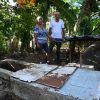Monday, April 29, 2024
News and Views from the Global South
Opinion
Rwanda: A Ravaged Country That Bounced Back

Credit: UN Photo/Loey Felipe
Hate speech is an alarm bell – the louder it rings, the greater the threat of genocide, UN Secretary-General Antonio Guterres said last year as the General Assembly commemorated the International Day of Reflection on the 1994 Genocide against the Tutsi in Rwanda.
- As we contemplate the clouded futures of Gaza, Ukraine, and other dire conflict zones that get far less coverage, it may be instructive to recall the surprising success story of a ravaged country that bounced back: Rwanda.
Rwanda’s Genocide Against the Tutsi began 30 years ago this week, and a week of national mourning is underway. The death toll was an order of magnitude worse than in Gaza today: between 500,00 and a million Rwandans were slaughtered in less than three months, and mass graves are still being uncovered.
The U.S saw the victims as “casualties of war” and refused to use the word “genocide.” It stood by as the death toll mounted, an unsettling parallel with U.S. statements and actions on Gaza today. In fact, the US blocked efforts to stop the killing. It led a successful bid to remove UN peacekeepers and stopped UN authorization of reinforcements. It seemed to have made a decision to leave Rwandans to their fate.
No one could have predicted what happened in the wake of the genocide. Since 1994, survivors and attackers reconciled. Life expectancy more than doubled. In fact, 98% of Rwanda’s population now has health insurance.
A million Rwandans have been lifted out of poverty. Rwanda now leads the world’s second largest continent in socio-economic development. It ranks highest for ease of doing business and investment.
It also leads Africa in modelling home-grown solutions for seeking justice, fighting poverty, and promoting gender equity and civic participation. Women are now the majority in Parliament.
All this was unimaginable 30 years ago. How did it happen?
Once the killing had stopped, Rwanda found a creative vision and new ways to seek justice and hold its new leaders accountable for post-genocidal progress. The restorative justice approach of Rwanda’s Gacaca courts was one of the world’s most ambitious post-conflict justice and reconciliation programs.
Over a ten-year period, a million suspects were tried in community-based courts. They confronted war crimes while fostering forgiveness and inclusiveness, allowing communities to heal.
Rwanda’s homegrown Imihigo system, based on pre-colonial cultural practices, reformed the formerly highly centralized government using a decentralized, performance-based governance model that delivered services the traumatized population needed.
Local and national leaders are periodically required to demonstrate the progress and the impact of policies. That contributed to verifiable improvements in access to services, human development indicators, and local political participation.
Since the genocide, gender equity has been embedded in Rwanda’s constitution and its education system, transforming politics, economics, and family life. Today Rwandan women are visionary leaders. Half of the President’s cabinet and 61% of Members of Parliament are female. Rwanda has near-universal primary school enrollment – girls included. With its innovative IT education and nationwide digital network coverage, Rwanda has become a model of educational progress.
So, what lessons can we learn from Rwanda about resilience and reconstruction after the convulsions of war and genocide and how they apply to war-ravaged countries today?
First, we can’t repeat the mistakes of 1994. The U.S. and the international community must stand up to stop the slaughter, and make sure food and access to health care are assured.
Once the killing stops, reconciliation is the way to start rebuilding. If reconciling the antagonists in the Middle East seems hopeless or impossible, just look at Rwanda. In 100 days, over a million members of the Tutsi minority group, as well as Twa and Hutu who and stood up against the genocide, were murdered by Hutu militias.
“The dead of Rwanda accumulated at nearly three times the rate of Jewish dead during the Holocaust,” Philip Gourevitch wrote. “It was the most efficient mass killing since the atomic bombings of Hiroshima and Nagasaki.”
Yet even so, the antagonists eventually came together. It required extraordinary political will, and belief in the impossible. But it happened. Together Rwandans were able to fashion and implement home-grown solutions to their shared problems.
The emphasis on gender equity, on women as visionary leaders, not victims, is also key. Research shows that countries that promote women’s rights and increase their access to education and economic opportunity grow faster, are more peaceful, and have less inequality and less corruption compared to countries that don’t.
Rwanda has many remaining challenges, but it staged one of the most impressive comebacks of modern times. Its leaders, led by President Kagame, rejected the policies of hate and division and retribution, and rebuilt the country from the ashes.
That provides some hope and evidence that Gaza, Ukraine, and other conflict-ravaged countries can too. Thirty years after the genocide, Rwanda is living proof that it is possible.
Professor Margee Ensign is the President of the American University in Bulgaria and author of Rwanda: History and Hope and co-editor of Confronting Genocide in Rwanda.
IPS UN Bureau

 Print
Print



